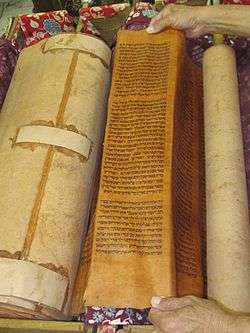Gevil
Gevil or Gewil (Hebrew: גויל) or (Hebrew: גוויל) is animal hide made of whole parchment that has been prepared as a writing material in Jewish scribal documents, in particular a Sefer Torah (Torah scroll).

According to most views of Jewish Law, a Torah scroll (Sefer Torah) should be written on gevil parchment, as was done by Moses for the original Torah scroll he transcribed.[1] Further, a reading of the earliest extant manuscripts of the Mishneh Torah indicate that gevil was halakha derived from Moses and thus required for Torah scrolls.[2]
Maimonides wrote that it is a law given to Moses at Sinai that a Torah scroll must be written either gevil or klaf in order to be valid, and that it is preferable that they be written on gevil.[3]
Etymology
Related to גויל, gewil, a rolling (i.e. unhewn) stone, cf. he:wiktionary:גול, "to roll." (Jastrow)
Definition of gevil
Gevil is a form skin for safrut (halakhic writing) that is made of tanned, whole hide. The precise requirements for processing gevil are laid down by the Talmud, Geonim and Rishonim.
- Rabbi Ḥiyya bar Ami said in the name of Ulla: There are three [untanned] hide [stages before it is tanned into gevil]: Matza, ḥifa, and diftera.
- א"ר חייא בר אסי משמיה דעולא ג' עורות הן מצה חיפה ודיפתרא — Gittin 22a; Shabbat 79a
According to law, the preparation of gevil must include salt, flour and mey afatzim (wasp residue/gall-nut water). (Shabbat. 79b) These requirements were reconfirmed as a Law given to Moses at Sinai by Maimonides, in his Mishneh Torah. Gall nuts—rich in tannic acid—are a tree's reaction to an invasive parasitic wasp's egg; the pure black tint of the ink used on Torahs results from the reaction between the tannic acid and iron sulfate (a powder used to make the ink).[4]
There are three forms of tanned skin known to Jewish law. The other two forms (qelaf and dukhsustus) result from splitting the hide into two layers; however, there is some dispute as to their identification. Others deviate from the traditional process and use modern chemical processes instead. However, some believe that this invalidates the parchment for scribal use.
According to the Halakhot Gedolot, klaf is the inner layer, adjacent to the flesh, while dukhsustos is the outer layer, on which the hair grows:
- תניא הלכה למשה מסיני תפילין על הקלף ומזוזה על דוכסוסטוס וקלף במקום בשר ודוכסוסטוס במקום שער.
- A baraita states: It is a Law given to Moses at Sinai that tefilin are written on qelaf and mezuzah on dukhsustus. Qelaf, on the flesh side; dukhsustus, on the hair side. — (Hilkhot Tefilin, perek 25 daf 100 in Venice 1548 printing)
The same view is expressed in the oldest extant manuscripts and critical editions of Maimonides' Mishneh Torah and the Babylonian Talmud (Shab. 79b). This is also the same definition which appears in the minor Talmudic tractate called Sofrim. However, more recent authorities reverse the two descriptions, and many printed editions of the Mishneh Torah are "adjusted" to reflect this. The reason for this original adjustment away from the original definition is a mystery. Some suspect that copying errors are to blame. As a result, many have become confused, in terms of which part of the skin should be used for writing. Using the full hide known as gevil for Sifrei Torah does avoid this issue, but unfortunately this solution won't work for tefilin which must be written on Klaf and are not kosher if written on gevil.
Uses of gevil
According to the Talmud, Moses used gevil for the Torah scroll he placed into the Holy Ark of the Covenant.[5] Elsewhere in the Talmud, there is testimony that Torah scrolls were written on gevil.[6]
Today, a handful of Jewish scribes and artisans continue to make scroll material in this way. However, the majority of Torah scrolls are written on klaf, in their belief that the Talmud recommends (as opposed to requires) gevil and relates to the optimal beautification of the scrolls rather than an essential halachic requirement. Given the uncertainty about which layer of the hide is in fact the klaf, there is a growing movement for insisting on a return to gevil in Torah scrolls - in order to avoid all doubts. Clearly, the antiquity of gevil (as the original practice) is not being debated by anyone.
Most of the Dead Sea Scrolls (200 BCE), found in and around the caves of Qumran near the Dead Sea, are written on gevil.
Properly, klaf should be used for tefillin and duchsustus for mezuzot. Once more, this rule is often relaxed in practice but there is a minority which seeks to return to the actual law.
See also
References
- Talmud, Bava Batra 14b and Gittin 54b
- Mishnah Torah - Hilkoth Tefillin 1:8
- Mishneh Torah, Hilkhoth Tefillin 1:14
- Shabboth 79a
- Bava Batra 14b; Gittin 54b
- Gittin 54b
External links
- The Gevil Institute: Machon Gevil The only online organization dedicated to the preservation of gevil.
- https://web.archive.org/web/20080410134250/http://www.ccdesigninc.com/MishmeresStam/Leaflet.pdf
